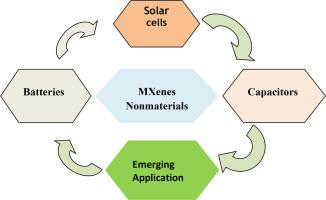MXenes纳米材料在能源应用中的最新进展
引用次数: 0
摘要
MXenes是一类二维过渡金属碳化物、氮化物和碳氮化物,已成为一类开创性的纳米材料,在能源应用方面具有巨大潜力。它们独特的特性,如高导电性、可调节的表面化学性质和大表面积,使它们成为能量存储和转换技术的完美候选者。MXene合成的最新进展,如嵌层和分层技术,使制造高性能电池、超级电容器和燃料电池电极成为可能。此外,MXenes已被证明在催化、制氢和二氧化碳减排方面具有显著的效率,进一步巩固了它们在解决世界能源问题方面的作用。在混合材料中加入MXenes为提高其电化学性能和稳定性创造了新的机会的同时,研究人员已经研究了新的策略,如表面改性和原位制造,以优化基于MXenes的设备的长期使用,并且计算研究已经对MXene纳米结构与其能量相关特性之间的关系产生了重要的见解。尽管取得了这些进展,但扩大生产和提高基于MXenes系统的机械稳定性仍然是一项艰巨的任务,进一步的研究和合作是必要的,以便在未来充分利用MXenes开发可持续和有效的能源解决方案。本文综述了MXenes的结构特性及其在能量转换和存储系统中的潜在新应用。它研究了MXenes如何以其独特的特性帮助推进能源技术。本文还讨论了它们在提高各种能源电器的效率和性能方面的作用。此外,本文评估了MXene纳米材料的最新突破,包括它们的优势和局限性。它介绍了MXenes在电池、太阳能电池、电容器和氢气生产等能源相关技术方面取得的进步。这项研究旨在突出MXenes在解决该领域现有问题的同时,对尖端能源解决方案的贡献。本文章由计算机程序翻译,如有差异,请以英文原文为准。

Recent advances in MXenes nanomaterials for energy applications
MXenes are a family of two-dimensional transition metal carbides, nitrides, and carbonitrides that have become a pioneering class of nanomaterials with enormous potential in energy applications. Their distinctive characteristics, such as high electrical conductivity, tunable surface chemistry, and large surface area, make them perfect candidates for energy storage and conversion technologies. Recent developments in MXene synthesis, like intercalation and delamination techniques, have made it possible to create high-performance electrodes for batteries, supercapacitors, and fuel cells. Additionally, MXenes have proven to be remarkably efficient in catalysis, hydrogen production, and carbon dioxide reduction, further solidifying their role in tackling the world's energy problems. While the incorporation of MXenes into hybrid materials has created new opportunities to improve their electrochemical performance and stability, researchers have investigated novel strategies, like surface modification and in-situ fabrication, to optimize MXene-based devices for long-term use, and computational studies have yielded important insights into the relationship between MXene nanostructures and their energy-related properties. Despite these developments, scaling up production and improving the mechanical stability of MXene-based systems remain difficult tasks, and further research and cooperation are necessary to fully utilize MXenes in the development of sustainable and effective energy solutions for the future.This review focuses on the structural properties of MXenes and their potential new applications in energy conversion and storage systems. It investigates how MXenes, with their distinctive properties, can help to advance energy technologies. The article also discusses their functions in improving efficiency and performance in various energy appliances. Furthermore, the paper evaluates recent breakthroughs in MXene nanomaterials, including their advantages and limitations. It addresses the advancements that MXenes have made in energy-related technologies such as batteries, solar cells, capacitors, and hydrogen production. This study intends to highlight MXenes' contributions to cutting-edge energy solutions while addressing existing problems in the field.
求助全文
通过发布文献求助,成功后即可免费获取论文全文。
去求助

 求助内容:
求助内容: 应助结果提醒方式:
应助结果提醒方式:


